
Days two and three were as hectic, if not more, than day one.Day two started off with Andrew Allen giving his insight on the publication guidelines for small-angle scattering data (which happens to also be the topic of one of my blog post drafts). While there have been a few papers dictating guidelines for measurements on biological systems, these may only be partially relevant for other applications of SAS.
To summarize: the whole idea here is that data is deposited in a comprehensive format, so other researchers can take that data and reinterpret as they see fit. This does, however, require some journals to move away from the standpoint that only publications are considered that discuss original material (a problem encountered in the stripy-nanoparticle saga).
Prof. Ruland has been known to re-analyse existing data (meticulously extracted from published curves by his secretary), however, so this may not be as big an issue as I imagine it to be.
This talk tied in nicely with Andrew Jackson’s overview of the state of CanSAS2012, a (very flexible) format for storing data with all metadata. This format was discussed on day three in a small discussion group, and apart from a few minor naming issues it seems to be ready to go. My active participation did mean that I have been dragged into the working group to help with some of the final touches. Let us see what comes of that.
On the plus side, it very much looks like the CanSAS2012 definitions will become an official NeXus application definition, adding legitimacy as well as a driving force behind the efforts to complete the data formats work.
Day two also had a very lively discussion on calibration standards. I did write some notes on that which should appear on the CanSAS wiki sooner or later. I also suggested using one of Zoë Schnepp‘s samples to check the coherence limitation of data, although I will be indebted to her for synthesizing a few hundred grams of that!
On day three (during a session I chaired), Yuya Shinohara from Tokyo U. talked a little about coherent scattering. As I discussed the considerations of coherence in my prior talk, he was so kind to change his talk somewhat to discuss coherence and basically agree with the thoughts. He and his colleague appear to be close to publishing about that, so that should be interesting to follow.
Charles Dewhurst (from ILL) talked about the value of playing with neutron scattering instruments. He designed his to have a few too many optical components than strictly necessary. This gave him the chance to abuse their SANS instrument to do uncommon things such as characterising his waveguide (which turned out to be misaligned), image the cold source, do multibeam (U-)SANS and some imaging!
U-ser Jeng from Taiwan then talked about their “old” and new synchrotron, and the small-angle scattering beamline efforts on that. They have managed to get an in-situ spin-coater and HPLC system in place on a beamline the design of which strongly resembles the SAXS beamlines at SPring-8.
There were some more talks and discussions in the afternoon on GISAS, however my poor knowledge on that topic caused me to mentally miss the content quite a bit. Fortunately, much of the content discussed at this conference is gradually becoming available on the wiki.
Finally, some piss-poor images of the final days of the meeting:

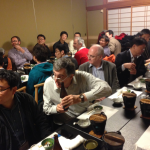
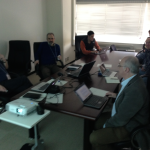
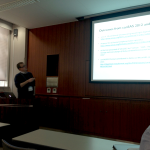
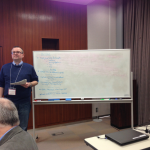
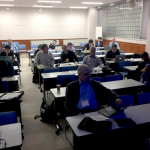
Leave a Reply